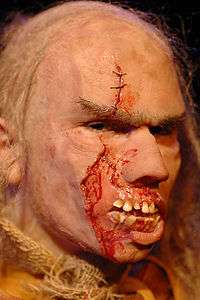Prosthetic makeup


Prosthetic makeup (also called Special make-up effects and FX prosthesis) is the process of using prosthetic sculpting, molding and casting techniques to create advanced cosmetic effects. Prosthetic makeup was revolutionized by John Chambers in such films as Planet of the Apes and Dick Smith in Little Big Man.
Technique
The process of creating a prosthetic appliance begins with lifecasting, the process of taking a mold of a body part (often the face) to use as a base for sculpting the prosthetic. Lifecast molds are made from prosthetic alginate or more recently, from skin-safe silicone rubber. This initial mold is relatively weak and flexible. A hard mother mold, typically made of plaster or fiberglass bandages is created overtop the initial mold to provide support.
Once a negative mold has been created, it is promptly filled with gypsum cement, most commonly a brand called "Ultracal-30", to make a "positive" mold. The form of the prosthetic is sculpted in clay on top of the positive. The edges of the clay should be made as thin as possible, for the clay is a stand-in for what will eventually be the prosthetic piece. Along the edges of the mold, "keys" or mold points are sculpted or carved into the lifecast, to make sure that the two pieces of the mold will fit together correctly. Once sculpting is completed, a second mold is made. This gives two or more pieces of a mold - a positive of the face, and one or more negative mold pieces of the face with prosthetic sculpted in. All clay is carefully removed and the prosthetic material is cast into the mold cavity. The prosthetic material can be foam latex, gelatin, silicone or other similar materials. The prosthetic is cured within the two part mold - thus creating the beginning of a makeup effect.
One of the hardest parts of prosthetic make-up is keeping the edges as thin as possible. They should be tissue thin so they are easy to blend and cover giving a flawless look.
The use of prosthetic makeup to create wounds or trauma is called moulage and is used by the military and medical schools to educate and lessen psychological trauma when exposed to the real thing.
Notable artists
- Jack Pierce (Frankenstein (1931), The Mummy (1932), The Wolf Man (1941))
- John Chambers (Planet of the Apes original film series)
- Dick Smith (Little Big Man, The Exorcist)
- Rick Baker (An American Werewolf in London, The Nutty Professor, Men in Black, How the Grinch Stole Christmas)
- Tom Savini (Friday the 13th, Dawn of the Dead, Creepshow)
- Rob Bottin (The Howling, The Thing, Total Recall)
- Stan Winston (The Terminator, Predator, Jurassic Park)
- Gregory Nicotero (The Walking Dead)
- Howard Berger (The Chronicles of Narnia film series)
Notable examples
- Tyra Banks - ABC News: Tyra Banks Experiences Obesity Through Fat Suit - showcased on her eponymous talk show on 4 November 2005
- Jennie Bond: Posh Swap: Jennie Bond (makeup process)
- Nina Bott: Stern TV fat makeup (before and after; makeup process).
- Vicki Butler-Henderson: Celebrity Swap. :(Vicki's entire head is covered with prosthetics during the makeup application.)
- Samantha Fox: Race Swap and makeup process.
- Julie Goodyear: Age Swap and makeup application.
- Tommy Lee Jones: Harvey Dent/Two-Face in Batman Forever.
- Rebecca Loos: Gender Swap and makeup application.
- Kelly Lynch: [Mr Magoo] (various disguises, the old lady and makeup application, the balding man).
- James McAvoy among others in The Chronicles of Narnia: The Lion, the Witch and the Wardrobe.
- Rik Mayall: Drop Dead Fred
- Larissa Meek: Average Joe Hawaii (plus makeup application and unmasking)
- Melinda Messenger: Celebrity Swap. (The makeup application for Melinda)
- Jack Nicholson: Jack Napier/The Joker in Batman (1989 film).
- Caroline Palmer: The Sun photoshoots (fat and race swap).
- Ron Perlman: several times in his career, but most notably as Hellboy
- Brad Pitt: The Curious Case of Benjamin Button
- Katie Price (a.k.a. Jordan): Jordan Gets Even and makeup application.
- Linda Robson: Celebrity Swap. (Linda's makeup application)
- Melena Scantlin: The completed makeup and the reveal scene and the makeup process.
- Arnold Schwarzenegger: as iterations of the Terminator in The Terminator and its sequels Terminator 2: Judgment Day and Terminator 3: Rise of the Machines.
- Carol Smillie: Gender Swap and makeup application.
- Lea Thompson: A Will Of Their Own; Back To The Future Part II and Back To The Future (including makeup application).
- Many actors in The Lord of the Rings film trilogy, notably John Rhys Davies and various actors/stuntmen portraying orcs.
See also
References
- "Prosthetic Makeup". How It's Made. Discovery Channel.
- "Disguise". The Most Extreme. Animal Planet.
- "Truffle Forager and Food Make-Up Artist". Will Work for Food. Food Network.
| Wikimedia Commons has media related to Prosthetic makeup. |